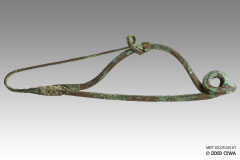Celtic bronze fibula, La Tene, 500 BC

Links to other views:⇒ Larger Viewif scripting is off, click the ⇒ instead. Links to others of type FibulaGilded bronze fibula, Byzantium, 400 ADLarge gold pin, Etruria, 700-600 BC Silver pin with ibexes, Luristan, 750 BC Spectacle fibula, Greece, 950-800 BC Votive boat fibula, Etruria, 750-650 BC |
This Celtic bronze fibula is from La Tene, a site on the shores of Lake of Neufchatel in Switzerland, around 500-400 BC. “Changes in shape and decoration of brooches give a guide to Iron Age chronology… In the sixth and fifth century BC the catch-plate often ended in an upright decorative finial. From the fifth to the third century this foot was turned back towards the bow; then, in the third and second century, it was clasped to the bow by a collar. Eventually in the first century BC, it came to be cast in one piece with the bow” (Tait 1991:72). Tait (1991:73, fig. 161) documents a similar fibula as coming “ from the type-site of La Tene itself and dates to the Middle La Tene period (2nd century BC). It was made in a single piece, with the end of the foot bent round to clasp the bow.” Bibliography (for this item)Tait, Hugh1991 Jewelry: 7000 Years: An international History and Illustrated Survey from the Collections of the British Museum (republication of the 1987 edtion by H. N. Abrams). Abradale Press, New York, NY. ( 73, fig.161 72) |